Enterprise Social Software Case Study: Intrawest Placemaking
by Chris McGrath | Nov 23, 2006
This is a little longer than my usual quick tips--it's a case study of the social intranet of one of my clients, Intrawest Placemaking. Eight screenshots are included below.
It's not too often outsiders get a chance to see the intranets of other companies. I hope you enjoy it!
Background
Client
Placemaking (325 employees) is the real estate development division of Intrawest (25,000 employees). Placemaking is 100% knowledge workers. They develop resort villages worldwide, including Whistler-Blackcomb (British Columbia), Mountain Creek (New Jersey), and Tremblant (Quebec).
Project history
Tracy Hutton, Director of Learning at Placemaking, wanted to leverage the company intranet to create community at the recently re-organized company. She also wanted a better way to capture Placemaking’s intellectual capital online.
The existing intranet, released in May 2004, was infrequently updated and poorly used (averaging 0.5 page views per employee per day).
Hutton needed to redevelop the new intranet, and then maintain it, without a single full-time resource on the project.
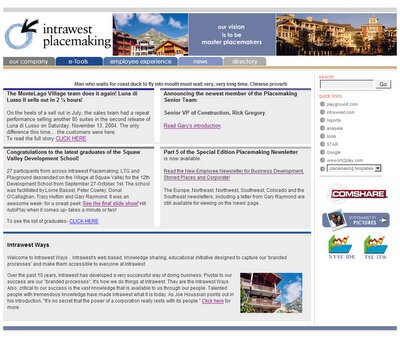
Placemaking's original intranet, May 2004
Solution
Solution: Social Software
Creators of ThoughtFarmer social software, Chris McGrath and Darren Gibbons, approached Hutton with the idea of using wiki-type technology to create a self-sustaining intranet democratically maintained by the entire company.
Hutton embraced the idea and won support of senior management. The redesigned intranet was launched in April 2006 on the ThoughtFarmer social software platform.
Enterprise 2.0 features
Placemaking’s new intranet is built on the wiki principle of open editing. All employees have the ability to add and edit content, even on the home page. Recent changes are listed on the home page and a search engine indexes all content. Pages and people are intertwined: each page is linked to the author’s profile and their profile page links to pages by that person.
Unlike wikis, Placemaking’s intranet has a hierarchical content structure with auto-generated navigation. It was felt that non-technical business users wouldn’t be comfortable with WikiWords and free-form page creation. Instead, clicking the “Add a page” button creates a subpage of the current page.

Placemaking's collaborative intranet, April 2006
Successes
Tenfold increase in use
At launch, intranet use immediately increased tenfold to 5 page views per employee per day. The increased use has held steady for 6 months. Use is pervasive. There were 1486 unique users in the second quarter after launch. With just 325 employees, this means over 1000 non-Placemaking employees—mostly employees of the parent company, Intrawest—used Placemaking's intranet. (Although it's not advertised, all of Intrawest's 25,000 employees—including those working in the lodging and ski operations divisions—have read-only access to Placemaking's intranet.)
Knowledge sharing that saves money
In September, Mike Hartigan, a Placemaking project manager in Vancouver, created a page about a method of finishing concrete floors that creates an appearance better than tile at a substantially lower cost. Using the method at the entrance to a resort saved $500,000 and reduced the project timeline. Other project managers in Florida and Nevada posted comments to the page, asking further questions. In response, Hartigan posted photos of the finished job and addressed their comments. The other construction managers planned on using the information on future projects.
On another occasion, a construction manager shared his approach for lighting supply for condo-hotel development. By using a light broker to assemble the lighting package and gather competitive bids, he saved about $200,000 on a typical $30 million project.
Placemaking manages dozens of multi-million dollar developments a year. These construction tips, if implemented on just a handful of projects, will save the company millions of dollars. Without the everyone-is-an-editor intranet, it is doubtful that they would have been shared.

Construction manager Mike Hartigan shares a technique for polishing concrete that looks better than tile
Employee "places" popular
The first social feature of ThoughtFarmer to resonate with Placemaking employees was Employee “Places”: a personal spot for each employee to add a profile and create pages. As employees uploaded photos of themselves, added amusing anecdotes, and revealed a little more of who they are, the popularity of People Places skyrocketed. Within 3 months, virtually all employees had added their own contact information, one-third had added a personal profile, and 15% had created pages.

Employee “Places”, where each employee can add a profile and create pages, were the first popular social feature of the new intranet
Six weeks after launch, an unplanned community "event" took place on the intranet. Two people changed their profile pictures to ones of actor Tom Selleck in the 1980’s TV show Magnum P.I. The change, like any other, was listed on the intranet home page. Within minutes, other users also changed their pictures to Magnum P.I. or to Magnum's butler, Higgins. Within 2 hours, dozens of employees had taken the idea and ran with it, sporting photos of 80s TV icons like Mr. T, Daisy Duke and Michael Knight. It was the talk of the office.
Although this event was of no immediate business value, it was a milestone in the adoption of the democratized intranet by the employees. From that point on, Placemaking seemed to "get" what their new collaborative platform was capable of.
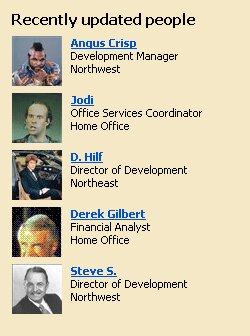
An unplanned community “event”: Users change their photos to those of 80s TV icons.
Company president a leading content contributor
Placemaking's president, Drew Stotesbury, has been an active user and proponent of the collaborative intranet, posting news articles, uploading photos, and starting new forum topics.
Placemaking's parent company, Intrawest Corporation, was recently acquired by Fortress Capital. During the period of uncertainty preceding the announcement of the acquisition, Stotesbury used the intranet to good effect in assuaging the concerns of employees. He posted regular updates on the impending transaction, invited questions, and posted answers.
Stotesbury's leading role contributed to a change in attitude amongst staff, as employees began to view the intranet as a serious tool and a viable platform for communication and discussion.
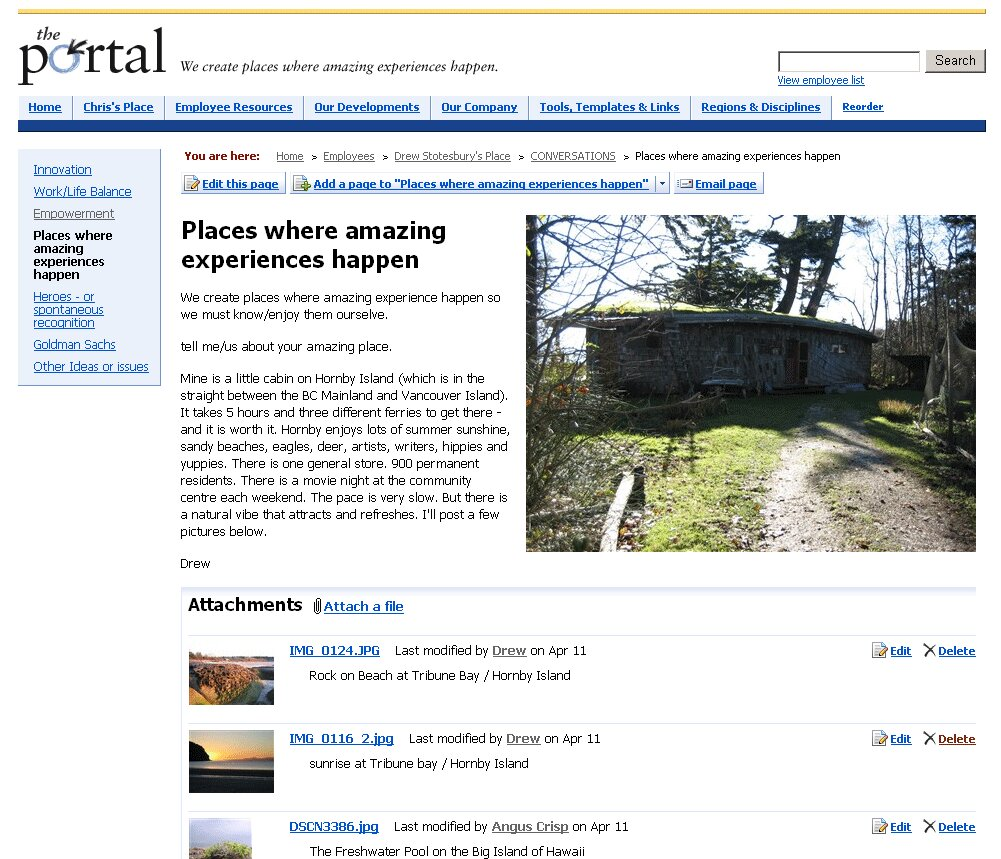
The company president is an active participant in the online community. Here he starts a conversation about “Amazing places”.
No misuse
In the six months since launch, there have been no incidents of employees misusing or abusing their ability to edit and post content. No content can be posted anonymously, as Placemaking’s intranet software integrates with their Windows network and Active Directory. Employees take responsibility for their own postings and this self-policing seems to be effective.
Challenges
Participation inequality
In any social system, a small group of users is usually responsible for the bulk of content creation. This holds true for Placemaking's intranet. On the encouraging side, about half of all users have gone beyond just updating their contact information, and have uploaded a picture, posted a comment, or created a page. Still, there is a small network of users (about 20) that is responsible for the vast majority of page creation, content edits, and forum posts. Getting the other 300 employees to not just lurk, but to actively participate, remains a challenge.
Participation is heaviest at Placemaking’s head office. Head office employees are 3 times more likely than non-head office employees to contribute content to the intranet and 5 times more likely to be frequent page editors. It is unclear why head office employees are more willing to participate in the social system. It may be due to the nature of their jobs. It could be that a critical mass of peers is participating, making others feel comfortable enough to join in.
System limitations
Software to support emergent collaboration in the enterprise is new and imperfect. No doubt some lack of user participation at Placemaking is due in part to limitations of the underlying software.
One feature the user community has repeatedly requested is a mechanism to alert them if a particular page changes — in Enterprise 2.0 parlance, "signals". While RSS is the preferred signal platform in tech circles, no Placemaking user has mentioned it: they want alerts delivered by email.
In December, Placemaking will migrate to ThoughtFarmer 2.0, which includes email-based signals when a requested page changes. In addition, Placemaking’s updated intranet will include content tagging, social bookmarking, and "related content" links. It is hoped that these system enhancements, all part of McAfee's "SLATES" formula for Enterprise 2.0 collaboration, will increase participation on Placemaking's intranet (A. McAfee, “Enterprise 2.0: The Dawn of Emergent Collaboration”, MIT Sloan Management Review, Spring 2006).
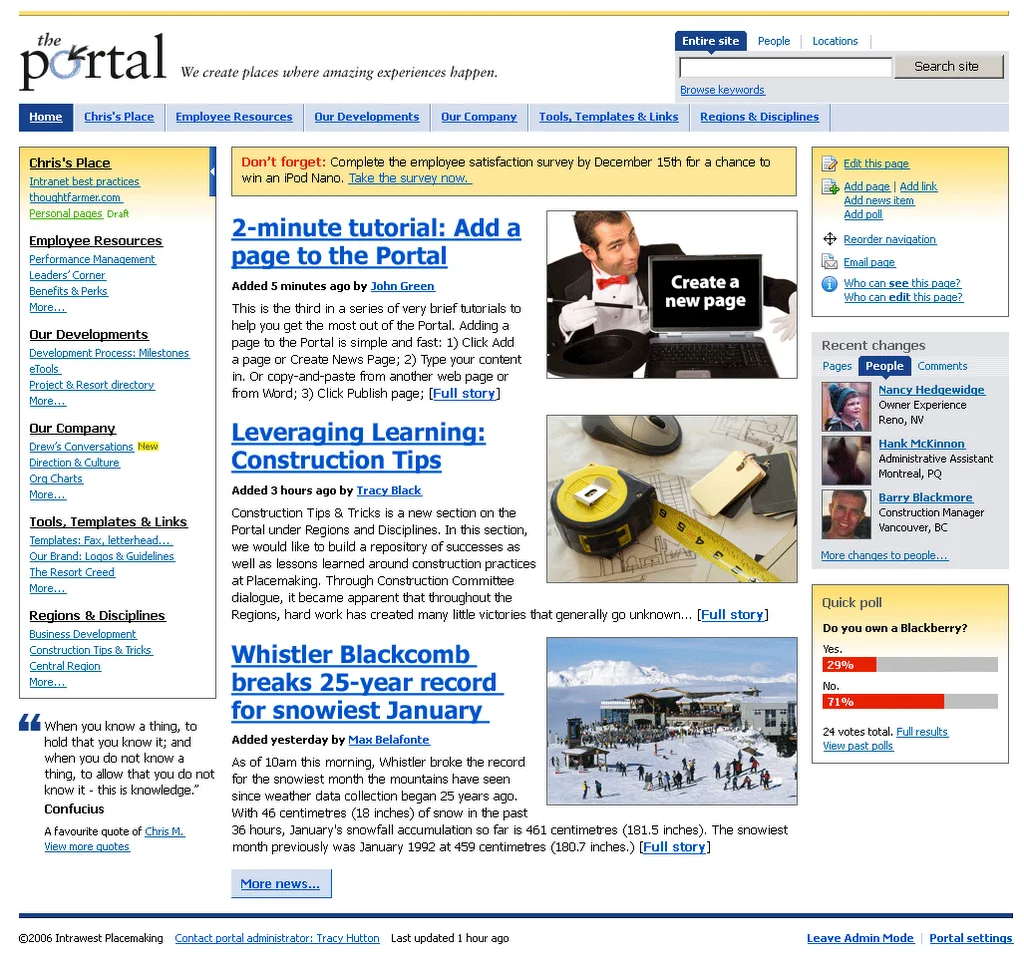
Placemaking plans more social features in a December upgrade to their intranet software
Everyone-can-edit is a foreign concept
Some users evidently do not edit intranet content because the concept is so foreign.
For example, one user posted a comment to a page with a recommended change: “Tracy, can we change out CW’s name for John’s? What is the procedure for updating the entire paragraph?” The user could have made the change himself by clicking the prominent “Edit this page” button.
User interface issues aside, if the user expected the ability to edit content, he would have found the edit button. But many users are still not expecting this ability. This cultural shift will take time.
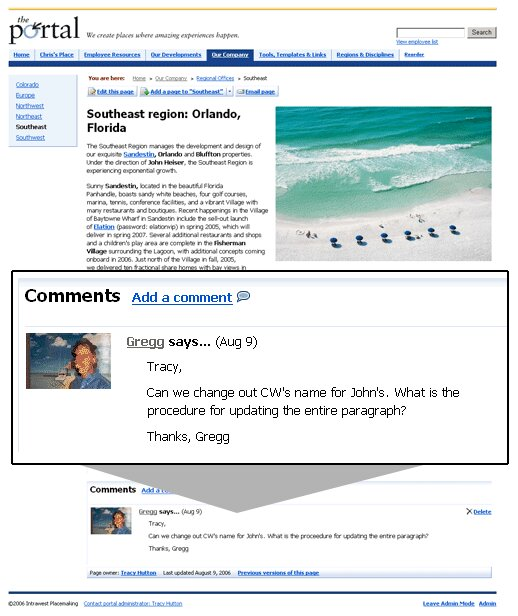
Many users don’t “get” that they can edit a page. Here, a user posts a comment asking the site administrator to make a change, even though he can click “edit” and make the change himself.
Key Learnings
Pays for itself
In a large company, the cost of an effective enterprise collaboration platform is trivial compared with the value of the knowledge that is shared. Placemaking's total investment in their intranet, including customizations and information architecture consulting, was under $100,000. That money is recouped by one construction manager implementing the suggestion to use a light broker.
Additionally, Hutton is convinced that the social software aspects of the intranet have strengthened the feeling of community at the company and helped foster loyalty among employees. These tacit benefits represent a return on investment that’s hard to quantify, but is very real.
Need easier ways for employees to add value to intranet
Currently, about 50% of Placemaking employees do not edit the intranet. 44% are occasional editors, and 6% are active participants. Although participation is high compared to internet-based social systems, we still need to look at new ways to get the 94% of low- or non-participators more involved.
One new feature to be added to Placemaking’s intranet in December is a simple social bookmarking system. Users can favourite a page with one click. Their lists of favourites are visible to others, and their favourites count as “votes” that impact search results.
User contribution can’t get easier than one click. It’s hoped that system enhancements like this one will serve to extract value from more employees.
Enterprise collaboration is a cultural shift
Placemaking is in an excellent position to take advantage of its social intranet. It’s a knowledge-based business. Its President is an active participant in the system. Its revenue per employee is very high, so any efficiencies or cost savings gained from sharing knowledge can have a significant bottom-line impact.
But employees can’t be forced to participate. They have to first see and believe that participating benefits them. That’s a cultural shift that will take time.